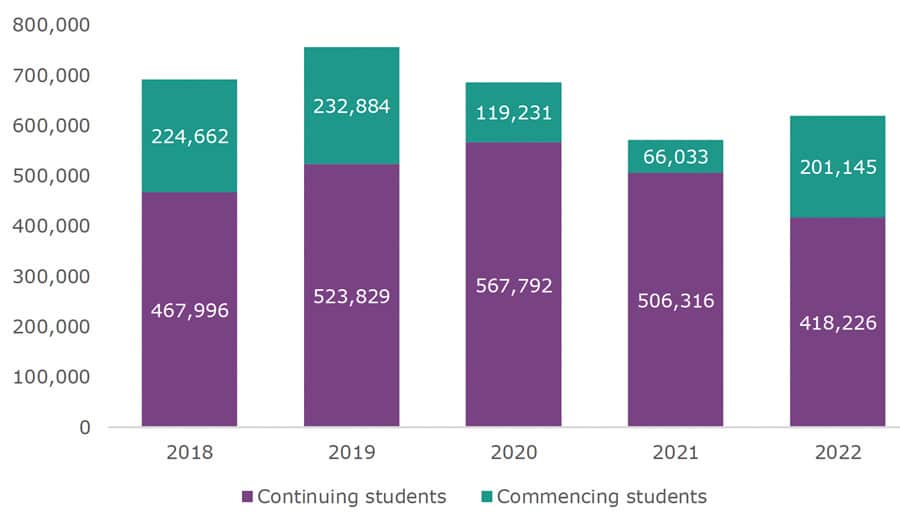International students are returning to Australia but not yet at pre-pandemic levels
- Australia’s international student numbers and overall enrolments were up in 2022, but they have not yet reached their levels before the pandemic in 2019
- The Chinese market is not rebounding, and Indian students now account for more commencements (first-time enrolments) than Chinese students do
- Driving the Australian international education sector’s recovery are new students from Thailand, Nepal, Colombia, Pakistan, and other emerging markets
Australia’s international education sector is recovering from pandemic losses, but it has not rebounded to pre-pandemic performance yet according to new data from Austrade.
Australian institutions enrolled 619,370 foreign students in 2022. This is up 8% over 2021 but is down 18% since 2019.
Commencements (first-time enrolments in Australian programmes) grew by 39% y-o-y but were 23% lower than in 2019. Fewer new Chinese students depressed commencement volumes: there were 39% fewer Chinese students in 2022 than in 2019. In 2022, India displaced China as the largest source of commencements.
Total course enrolments (as distinct from total international students) nudged upwards by 4% to 746,390 in 2022, but this is 22% lower than in 2019. (Australia provides data on both international students and international enrolments – the second is always a higher number as an international student may enrol in more than one course while on their study visa.)

Austrade notes the effect of Australia’s long 2020/21 border closure on enrolments, explaining that even more than 200,000 new students in 2022 couldn’t offset pandemic losses:
“Across 2022 there were 201,145 new students who began their studies with Australian educational institutions. This was 3 times the number from the previous year (66,023) and the highest intake of new students since 2019. However, the reduction in new students in 2020 and 2021, coupled with others completing their studies over the same period, saw the number of continuing students drop to a low of 418,226.”
Austrade also makes an astute observation about the forces that will affect the recovery of the country’s international education sector going forward:
“The pace at which total student numbers recover to pre-pandemic levels will be determined by how quickly the pool of new and continuing students rebound to outstrip those completing studies in the period ahead.”
The English-language sector (ELICOS), which made some strong year-over-year gains in 2022, is singled out as well in terms of how its fortunes will affect the overall industry’s recovery:
“Continued recovery and renewal in ELICOS enrolments are critical to the overall sustainability of international education. This is due to the sector playing a pivotal role in providing a pathway to further study. Students who complete ELICOS courses are more likely to pursue subsequent study in another international education sector.”
Which markets are the strongest for Australia?
Offsetting a decline in Chinese enrolments (177,470 in 2022, down 11% y-o-y) and zero momentum from India (128,980, up .03%) were notable enrolment increases from:
- Thailand, the 6th largest market, up 61% to 25,792
- Nepal, the 3rd largest market, up 21% to 71,805
- Colombia, the 4th largest market, up 21% to 28,435
- Pakistan, the 9th largest market, up 21% to 20,935
Combined, China and India still contributed half of all international enrolments in Australian institutions in 2022.
Foreshadowing the shape of the sector’s recovery in the years to come are commencement trends. Chinese commencements fell by 8% in 2022 compared with 2021, while Indian commencements increased by 45%, boosting India to the top market for Australia in terms of first-time enrolments in courses. Otherwise, the biggest stories in terms of commencements come from:
- Thailand, up 145%
- Nepal, up 94%
- Pakistan, up 71%
- Philippines, up 61%
In 2022, India and China each accounted for roughly 18% of commencements, with Nepal next at 11%.
How are the sectors faring?
Higher education: Enrolments up 1% over 2021 but down 18% on 2019; commencements up 38% over 2021 with the largest increases concentrated in postgraduate courses (up 51%).
VET: Enrolments down 3% compared with 2021 and 2019; commencements up 10% over 2021.
ELICOS: Enrolments up 90% compared with 2021 but still only half of their level before the pandemic; commencements up 155% over 2021.
Offshore versus onshore
Offshore enrolments were crucial to Australian educators’ ability to keep afloat during the pandemic when borders were closed. Now that borders have been open for more than a year, they remain important but are declining relative to onshore enrolments. In March 2023 compared with March 2022:
“The number of primary student visa holders studying in Australia increased by 57 per cent or 188,174 while those studying offshore dropped 43 per cent or -50,269. This saw the share of student visa holders studying in Australia lift from 74 per cent to 89 per cent between 14 March 2022 and 13 March 2023.”
For additional background, please see:















